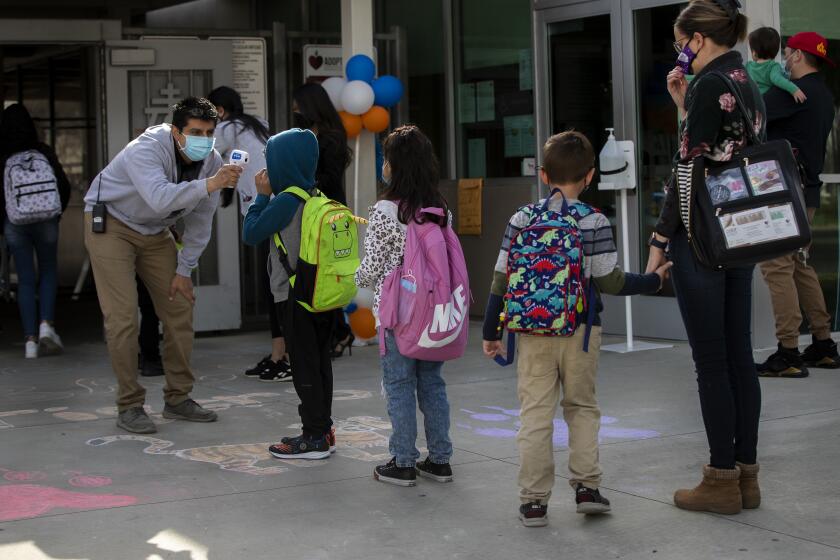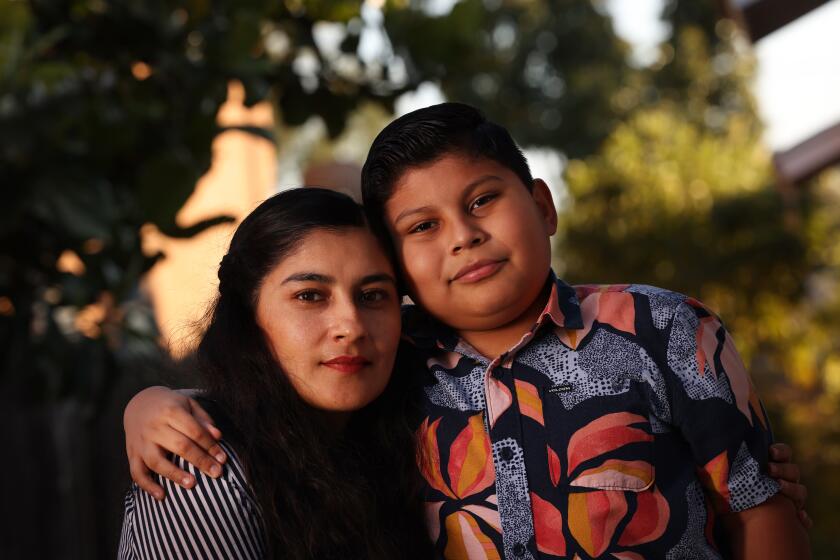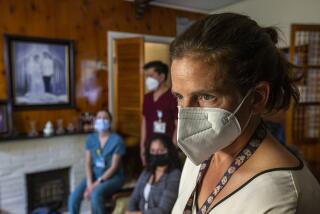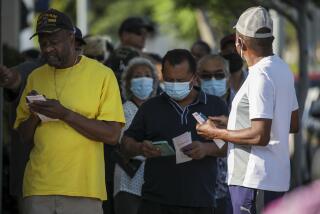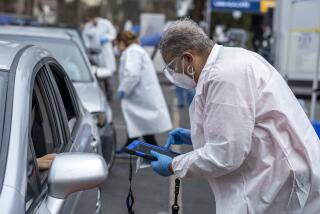As COVID vaccinations rise, L.A. strides into a world where ‘new normal’ is anything but
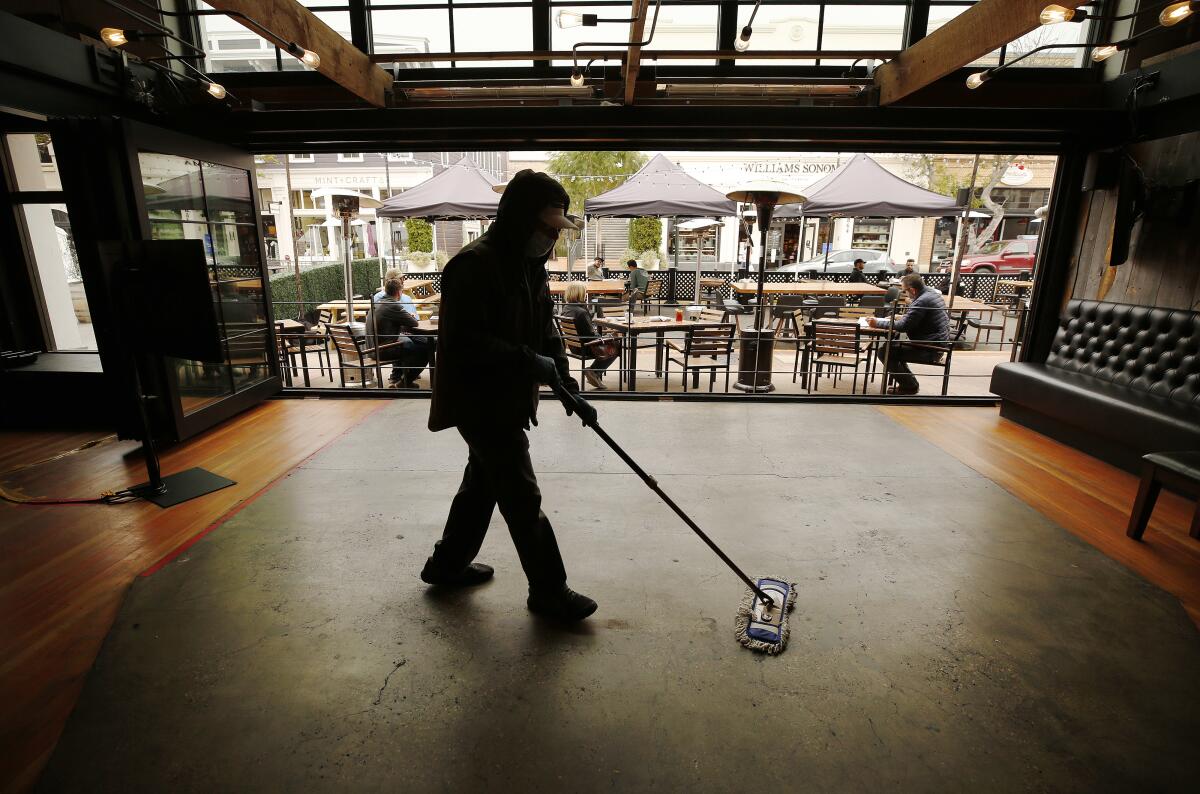
- Share via
Southern California is set to take giant steps toward something more closely resembling pre-pandemic life as some economic restrictions that have been in place for months are close to being lifted, with some major changes possible in a matter of days.
This newest normal will still be a considerably different world, however — one marked by continued strict capacity limits for businesses, required masks and social distancing, and reduced or modified operations at public sites of all stripes, including schools, restaurant dining rooms, gyms and Disneyland.
With coronavirus cases down dramatically from the harrowing heights of the fall-and-winter surge, Los Angeles, Orange and San Bernardino counties are now on the precipice of exiting California’s purple tier, the most proscriptive of the state’s four color-coded reopening categories.
That trio of large, urban counties could move into the more lenient red tier in a matter of days. Ventura, Riverside and San Diego counties are a bit further away, but are poised to potentially do likewise as soon as next week.
The shift in categorical hue carries significant ramifications for local economies that have long been crushed by COVID-19 closures and interruptions.
In the red tier, counties can allow indoor restaurant dining and movie theaters to reopen at 25% capacity or up to 100 people, whichever is less. In-person classes also would be allowed to resume for students in grades seven through 12. Indoor gyms and dance and yoga studios can open at 10% capacity. Museums, zoos and aquariums can open indoor activities at 25% capacity, and nonessential stores and libraries can open at 50% capacity, up from 25%.
The agreement, which must be ratified by union members, would set up a combination of in-person and online learning.
While the shift alone will not spark a radical economic recovery, it will allow some of the hardest-hit industries — tourism and dining among them — to begin the long journey out of the pit the pandemic plunged them into.
Southern California’s renowned theme parks — centerpieces of the region’s normally robust tourist economy like Disneyland, Universal Studios, Knott’s Berry Farm and Six Flags Magic Mountain — have been closed for almost a year. Entering the red tier will allow them to finally open their doors to visitors, albeit with capacity initially limited to 15%.
That means theme parks will be much less crowded, but operators are still jumping at the chance to reopen.
Disney Chief Executive Bob Chapek told shareholders Tuesday that he hopes the theme parks at the Disneyland Resort in Anaheim will open “by late April.”
In another sign of momentum, a tentative agreement reached Tuesday between the teachers union and the L.A. Unified School District brought schools a critical step closer to a return to campus beginning in mid-April.
The agreement, which must be ratified by members, establishes safety parameters for a return to campus and lays out a markedly different schedule that still relies heavily on online learning.
California policymakers are pushing for schools to reopen. But there’s no consensus among parents and caregivers about whether students should return.
The school day would unfold under a so-called hybrid format — meaning that students would conduct their studies on campus during part of the week and continue with their schooling online at other times. Families would retain the option of keeping students in distance learning full time.
The new optimism is being fueled by two related developments: sustained drops in coronavirus cases and COVID-19 hospitalizations, and the slow but sure increase in vaccinations.
And state officials are now tying California’s economic fate to those two trends in a way they haven’t before.
In a bid to tackle the stubborn inequities that have dogged the state’s vaccine rollout, California is now dedicating 40% of its available supplies for residents in the most disadvantaged areas.
The other magic number, at least as far as reopenings are concerned, is 2 million. Once California has administered that many doses in targeted lower-income communities — as identified by the California Healthy Places index, a socioeconomic measurement tool — the state will relax the criteria for counties to move from the purple to red tiers.
Currently, counties must have an adjusted rate at or below seven new coronavirus cases per day per 100,000 people to move into the red tier. After the state hits its 2-million dose goal, which likely will occur this week, counties with a case rate of up to 10would become eligible for the red tier.
According to new state data released Tuesday, L.A., Orange and San Bernardino counties recorded rates low enough to enable them to escape the purple tier once this new criteria takes hold.
Because all three have logged adjusted case rates of less than 10 for the last two weeks, it appears they will be allowed to move soon after the state clears its vaccination hurdle. Without the change, none of them would be in position to advance this week.
California is currently about 103,000 doses short of meeting its goal, according to the latest available state data.
The counties’ case rates illustrate just how rapidly California has emerged from the darkest days of the surge.
The most recently released rates, which are adjusted based on the number of tests performed, per 100,000 residents, were 5.2 in L.A., 6.0 in Orange County and 6.7 in San Bernardino.
A month ago, the calculated case rates were 31.7 in Los Angeles County, 29.7 in Orange County and 32.7 in San Bernardino County.
Other areas of Southern California have seen similarly sharp declines and are also closing in on a potential move to the red tier. The latest state-tabulated adjusted case rates were, per 100,000 residents, 8.3 for Riverside County, 8.8 for San Diego County, 9.7 for Santa Barbara County and 9.1 for Ventura County.
However, all of those counties would need to record case rates below 10 for another week to be eligible to advance under the state’s relaxed criteria.
While officials are generally bullish about reopening, they said there are some cautionary notes in the data.
Daily coronavirus cases continue to decline in L.A. County and California, albeit at a slower place than the last few weeks. COVID-19 hospitalizations are also down.
But nationwide, there are worries about a plateauing of the decline in new daily coronavirus cases. There’s increasingly concern of a coming worldwide fourth wave of the pandemic; officials are concerned about cases starting to rise in Europe in the last week of February following six weeks of declines, said Los Angeles County Public Health Director Barbara Ferrer.
The hypercontagious U.K. variant of the coronavirus has spread quickly across the U.S., and now accounts for at least 10% of circulating cases of the coronavirus in L.A. County.
The worrisome New York strain of the virus has been identified in an outbreak of 11 people at a university in L.A. County, “and we’ll likely see more of these cases in the weeks ahead,” Ferrer said. “We will run the risk of delaying the pandemic if we don’t continue to reduce transmission while our vaccination numbers pick up.”
The governor emphasized his administration’s work to respond to challenges that “made the unthinkable commonplace” over the last year and pledged to address deep-rooted inequities further exposed by the pandemic.
Officials said this is a delicate moment, with businesses reopening even as vaccine supply is still limited. Following the rules will be essential to preventing another wave, they said.
“While vaccines provide a powerful additional layer of protection, we don’t yet have enough people vaccinated to prevent another — what would be disastrous — increase in cases, unless we’re going to remain committed to using the tools that we have at hand — our masking, distancing and hand washing tools — whenever people are around others not in their household,” Ferrer said.
In general, counties have been mostly following state guidance for reopening, but they have the ability to add restrictions if they consider them necessary. L.A. County supervisors were expected to discuss reopening rules privately this week, with some supervisors urging the county allow businesses to reopen with rules as permissive as the state allows.
Ferrer noted that a U.S. Centers for Disease Control and Prevention study found that allowing on-site dining at restaurants was associated with increases in new deaths, while mask mandates were associated with decreases in new deaths.
She also noted that top federal officials have urged states to be cautious in the reopening given the emergence of variants and the increasing number of cases.
Times staff writers Hugo Martin and Jaclyn Cosgrove contributed to this report.
More to Read
Sign up for Essential California
The most important California stories and recommendations in your inbox every morning.
You may occasionally receive promotional content from the Los Angeles Times.
